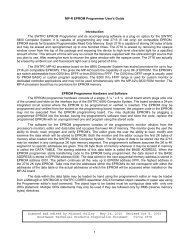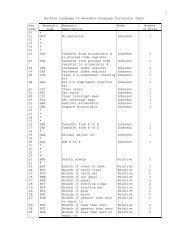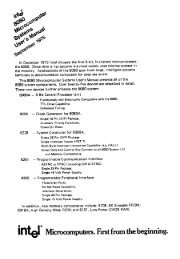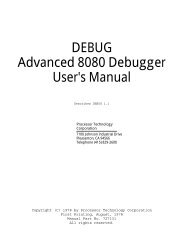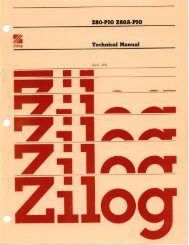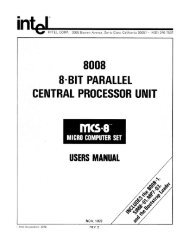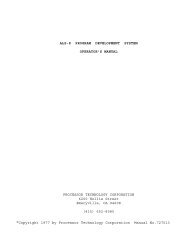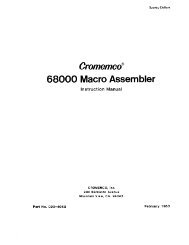The System Manual of SOL-20 - History of Computers
The System Manual of SOL-20 - History of Computers
The System Manual of SOL-20 - History of Computers
You also want an ePaper? Increase the reach of your titles
YUMPU automatically turns print PDFs into web optimized ePapers that Google loves.
PROCESSOR TECHNOLOGY CORPORATION<br />
Sol THEORY OF OPERATION<br />
SECTION VIII<br />
Data that enters Sol through the SDI/UART on pins 3, 12 or 13<br />
<strong>of</strong> J1 is input to the SDI UART on pin <strong>20</strong> by way <strong>of</strong> U38, an inverting<br />
level converter that converts data levels <strong>of</strong> up to 25 volts to TTL<br />
levels. (Note that current loop data on pin 12 or 13 <strong>of</strong> J1 is first<br />
rectified before it is applied to U38.) <strong>The</strong> UART converts this serial<br />
data into parallel form and outputs it on RO1 through RO8 (pins 12<br />
through 5 respectively) to the Internal Data Bus when ROD (pin 4) is<br />
low; that is, when !PORT_IN_F9 goes active.<br />
<strong>The</strong> receive-transmit clock for the SDI UART is supplied by<br />
the Baud Rate Generator (U84, U85, U86 and their associated circuitry).<br />
U85 is a phase locked loop, U86 is a 7-stage binary counter<br />
and U84 is connected as a divide-by-11 counter. <strong>The</strong> 1<strong>20</strong>0 Hz reference<br />
signal applied to pin 14 <strong>of</strong> U85 is supplied from the Video Display<br />
Generator. A phase comparator in U85 compares this signal to<br />
the output <strong>of</strong> a voltage controlled oscillator (VCO) in U85. By feeding<br />
an output from U86 (in this case the 1<strong>20</strong>0 Hz output on pin 3)<br />
back to the compare input (pin 3) <strong>of</strong> U85, the circuit acts as a frequency<br />
multiplier. <strong>The</strong> output (pin 4) <strong>of</strong> U85 remains locked, therefore,<br />
to a multiple <strong>of</strong> its input on pin 14. In this case we have a<br />
128X multiplier to generate 153.6 KHz which is counted down in U86.<br />
Since U86 is a 7-stage binary counter, the first stage output (pin<br />
12) is 76.8 KHz (one-half <strong>of</strong> 153.6 KHz, the clock for U86), the second<br />
stage output (pin 11) is 38.4 KHz (one-fourth <strong>of</strong> 153.6 KHz),<br />
the third stage output (pin 9) is 19.2 KHz (one-eighth <strong>of</strong> 153.6 KHz),<br />
and so on to the seventh stage output (pin 3) which is 1.2 KHz (1/128<br />
<strong>of</strong> 153.6 KHz).<br />
With the exception <strong>of</strong> outputs on pins 12 and 9, the outputs<br />
<strong>of</strong> U86 are connected to S3, the Baud Rate Switch. <strong>The</strong> 19.2 KHz output<br />
on pin 9 is divided by 11 in U84 to supply 1745 Hz to S3-2. <strong>The</strong><br />
38.4 KHz on pin 12 can be connected to S3-8 instead <strong>of</strong> the 153.6 Hz<br />
clock by cutting the L-M connection and installing a jumper between K<br />
and M.<br />
Let's now translate the frequencies input to S3 into Baud<br />
rates. <strong>The</strong> Baud rate <strong>of</strong> a UART is 1/16 <strong>of</strong> its clock rate. Thus, a<br />
1<strong>20</strong>0 Hz clock equates to a 75 Baud transmission rate, a 1745 Hz clock<br />
equates to a 109.1 (110) Baud rate, etc. It is now readily seen that<br />
the Baud rate available with S3-8 is 9600 assuming the L-M connection<br />
is made (153.6 KHz - 16 = 9600). (<strong>The</strong> L-M connection is default<br />
wired on the Sol-PC; that is, there is a trace between L and M on the<br />
circuit board. ) If the L-M trace is cut and a jumper is installed<br />
between K and M, the Baud rate with S3-8 is 4800 (76.8 KHz - 16 =<br />
4800).<br />
We can thus select any one <strong>of</strong> eight clock frequencies for the<br />
SDI UART with S3, with the highest being determined by the K, L and M<br />
jumper arrangement. <strong>The</strong> selected clock is applied to both the receive<br />
and transmit clock inputs (pins 17 and 40 respectively) <strong>of</strong> the<br />
UART. This means, <strong>of</strong> course, that the UART always receives and transmits<br />
at the same Baud Rate.<br />
VIII-<strong>20</strong>



